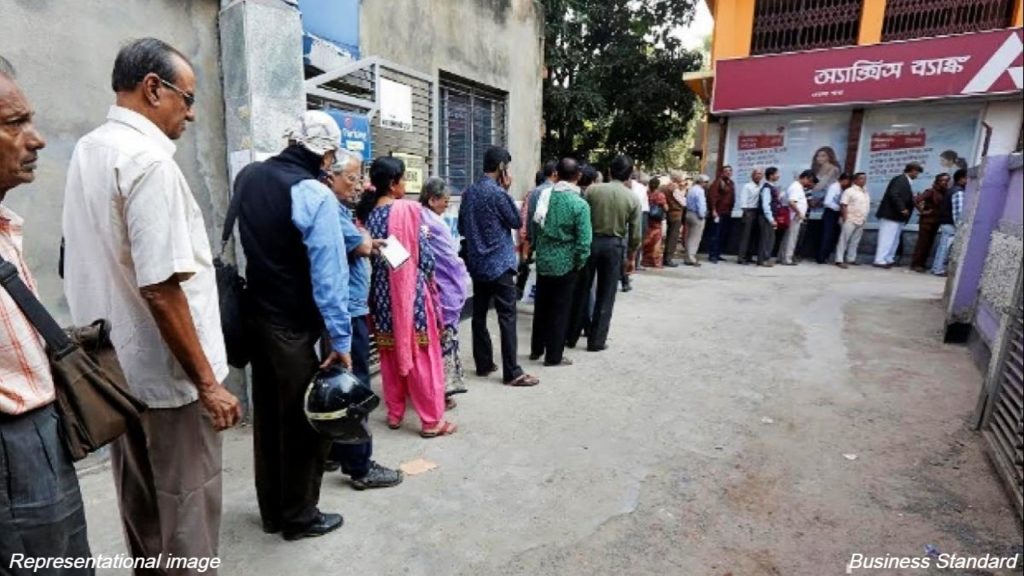Demonetisation: An unmitigated disaster

After five years, it is even more clear that demonetisation was a huge disaster for India. It brought about a policy-induced crisis and did little to stop the flow of black money.
The demonetisation of high-denomination currency notes on November 8, 2016, created a nightmare for citizens that lasted several months. Long queues formed outside the banks and ATMs to obtain swap denotified currency notes for new ones so that life could continue. This situation persisted even beyond December 30, 2016, the last day for depositing old notes.
Economic activity was severely dented for months. What the ruling party thought was a masterstroke turned out to be a disaster.
The sudden demonetisation was premised on the idea that “black means cash”. And, it is in high-denomination currency notes that black money would be held. So if the high-denomination notes were to be suddenly declared as illegal tender, then the black money of the rich would become null and void.
Just before demonetisation was announced, there was Rs 18 lakh crore of currency in circulation. Large-denomination currency notes of Rs 1,000 and Rs 500 constituted 85 per cent of that amount.
Flaws
The fatal flaw in the understanding behind the policy is that black money is not just cash. There is a distinction between income and wealth. Black income generation is a process based on economic activity. If a doctor sees 50 patients and declares the payment by 30, then the money paid by the rest is black income. This is an example of under-invoicing which is routinely practised by businesses. The savings out of this black income becomes one’s wealth which accumulates over the years.
The wealth is held in a variety of forms like, in undervalued inventory or balances held in tax havens abroad. A return is expected from this wealth. So, cash, on which there is no return, would be a tiny amount – 1 per cent of the black wealth.
Thus, if demonetisation managed to demobilise black cash, only 1 per cent of the black wealth would have been eliminated. But, the process of generating black incomes via mis-invoicing would continue.
Then, for the rich and well-connected, converting old currency to new notes proved to be easy, given the prevailing corruption. Some bankers were caught helping their rich clients do this. As a result, new black incomes got generated.
Deposits in Jan Dhan accounts suddenly swelled as the poor were used as cash mules. Businesses showed cash in hand to convert the old currency into new notes. Many such strategies were used for the purpose of conversion. The issue of new Rs 2,000 currency notes made it easier to hold black money.
The Reserve Bank of India conformed in August 2017 that by January 10, 2017, 99 per cent of denotified high-denomination notes had been returned to the banks. Where was the balance 1 per cent of the currency – in cooperative banks and abroad? In other words, all the old currency was accounted for.
In brief, demonetisation neither eliminated black money nor stopped black income from being generated.
Economy destroyed
On the other hand, it destroyed the economy. Cash to the economy is like blood which supplies nutrients to all parts of the body. Cash circulation enables transactions to occur, which help generate incomes.
If 85 per cent of the blood is taken out of the body and 5 per cent replaced every week, the body will die. Similarly, when 85 per cent of the currency in circulation was taken out and replaced little by little over about a year, the economy collapsed. If the currency had been restored within a few days, the damage would have been reversed.
The major component of the Indian economy is the unorganised sector, employing 94 per cent of the workforce. It consists of the micro and small units which work with cash and not through formal banking. While the organised sector was hit due to shortage of demand as people lost incomes, the unorganised sector just could not function without cash.
But official data showed that the year of demonetisation, 2016-17 had the best growth rate for the decade. The reason is that unorganised sector data is not available so the GDP data uses the organised sector as a proxy to capture it.
That may have been correct before the demonetisation but was problematic when the latter was declining while the former was growing. If alternative data were to be used it would have shown that the economy had gone into recession.
The long-term implications which go beyond the period of demonetisation are evident. There has been growing unemployment and increase in inequalities leading to a decline in demand. The result has been an economic slowdown even before the COVID-19 pandemic hit in 2020.
Demonetisation was an ill-advised step that did not achieve any of its goals, but damaged the economy no end, especially the unorganised sector.







